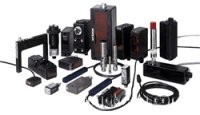okplazas.com analysis: the working principle of photoelectric sensor
okplazas.com analysis: the working principle of photoelectric sensor
okplazas.com analysis: the working principle of photoelectric sensor
The photoelectric sensor brands distributed by okplazas.com include Pepperl+Fuchs P+F, SICK SICK, Turck TURCK, Kerui CONTRINEX, Ike ELCO, Balluff BALLUFF, Ifm IFM, Festo Festo. What is a photoelectric sensor

The photoelectric sensor is a sensor that uses a photoelectric element as the detection element. It first converts the measured change into a change in an optical signal, and then further converts the optical signal into an electrical signal with the help of photoelectric elements. The photoelectric sensor is generally composed of three parts: a light source, an optical path, and a photoelectric element. The photoelectric sensor realizes control by converting changes in light intensity into changes in electrical signals.
The working principle of photoelectric sensor
In general, the photoelectric sensor is composed of three parts, which are divided into: transmitter, receiver and detection circuit. The transmitter is aimed at the target to emit a light beam, and the emitted light beam generally comes from a semiconductor light source, a light emitting diode (LED), a laser diode, and an infrared emitting diode. The beam is emitted continuously, or the pulse width is changed. The receiver is composed of a photodiode, a phototransistor, and a photocell. In front of the receiver, optical components such as lens and aperture are installed. Behind it is the detection circuit, which can filter out the effective signal and apply the signal.
In addition, there are emission plates and optical fibers in the structural elements of the photoelectric switch. The triangular reflector is a strong launching device. It is composed of a small triangular pyramid reflecting material, which can make the light beam accurately return from the reflector, which is of practical significance. It can change the emission angle from 0 to 25 relative to the optical axis, so that the beam is almost from an emission line, and after reflection, it still returns from this reflection line.
Classification and working methods
⑴ Slot-type photoelectric sensor
A light emitter and a receiver are mounted face to face on both sides of a slot is a slot-shaped photoelectric. The illuminator can emit infrared light or visible light, and the light receiver can receive light without obstruction. But when the detected object passes through the slot, the light is blocked, and the photoelectric switch is activated. Output a switch control signal to cut off or switch on the load current to complete a control action. The detection distance of the slot switch is generally only a few centimeters due to the limitation of the overall structure.
⑵ Through-beam photoelectric sensor
If the light-emitting device and the light-receiving device are separated, the detection distance can be increased. The photoelectric switch composed of a light emitter and a light receiver is called a through-beam separate photoelectric switch, or a through-beam photoelectric switch for short. Its detection distance can reach several meters or even tens of meters. When in use, the light emitter and the light receiver are respectively installed on both sides of the passing path of the detected object, and the light path is blocked when the detected object passes, and the light receiver acts to output a switch control signal.
⑶Reflective plate type photoelectric switch
The light-emitting device and the light-receiving device are installed in the same device, a reflector is installed in front of it, and the photoelectric control function is completed by the principle of reflection, which is called the reflector reflection type (or mirror reflection type) photoelectric switch. Under normal circumstances, the light emitted by the light emitter is reflected by the reflector and received by the light receiver; once the light path is blocked by the detection object and the light receiver cannot receive light, the photoelectric switch will act and output a switch control signal.
⑷Diffuse reflection type photoelectric switch
It also has a light-emitting device and a light-receiving device in its detection head, but there is no reflector in the front. Under normal circumstances, the light receiver from the illuminator cannot be found. When the detected object passes through and blocks the light and reflects the light part back, the receiver will receive the light signal and output a switch signal





